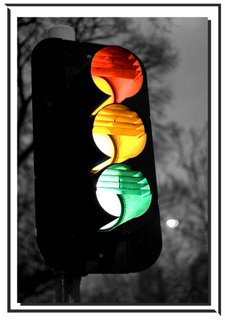
Taken near my house toad junction. This photo consist of three shots showing three diferrent state of the traffic light and combined by photoshop. The rest of the picture is made into black and white.
In most countries, the sequence is red (stop), green (go), amber (prepare to stop). In the UK and Canada, amber officially means 'stop' but in practice, is treated as 'prepare to stop'. In the UK, Hong Kong, mainland China, Germany, Poland, and Iceland, among others, the sequence includes red + amber together before green, which helps draw attention to the impending change to green, to allow drivers to prepare to move off. (In many of these jurisdictions, such as the UK, it is customary for drivers to shift into neutral and/or set the parking brake at red lights; the additional phase gives the driver time to shift into gear/release the brake before the light turns green). The single flashing amber signal is used in the UK and Australia at Pelican crossings. Some older signals in New England, mainly near Boston, use the red + amber phase to signify an all-pedestrian phase ("Barnes dance"), as they were installed before pedestrian signals came to the area, and before the national standard prohibited them. See "Pedestrian scrambles" below, or the main article.
In the mid 1990s, cost-effective traffic light lamps using light-emitting diodes (LEDs) were developed; prior to this date traffic lights were designed using incandescent or halogen light bulbs. Unlike the incandescent-based lamps, which use a single large bulb, the LED-based lamps consist of an array of LED elements, arranged in various patterns. When viewed from a distance, the array appears as a continuous light source (unless closely examined).
LED-based lamps have numerous advantages over incandescent lamps; among them are:
- Much greater energy efficiency
- Much longer lifetime between replacement, measured in years rather than months. Some of the longer lifetime is due to the fact that the light is an array which allows the light to be used even if some of the LEDs in the array are dead.
- Brighter illumination with better contrast even in direct sunlight.
- The ability to display multiple colors and patterns from the same lamp. Individual LED elements can be enabled or disabled, and different color LEDs can be mixed in the same lamp.
- Much faster switching.
The operational expenses of LED-based signals are far lower than equivalent incandescent-based lights. As a result, most new traffic light deployments in the United States, Canada and elsewhere have been implemented using LED-based lamps; in addition many existing deployments of incandescent traffic lights are being replaced. Many of the more exotic traffic signals discussed on this page would not be possible to construct without using LED technology.
In some areas, LED-based signals have been fitted (or retrofitted) with special Fresnel lenses and/or diffusers to limit the line of sight to a single lane. These signals typically have a "projector"-like visibility; and maintain an intentionally limited range of view.
In the late 1990s, a national standardization effort known as the Advanced transportation controller (ATC) was undertaken by the Institute of Transportation Engineers. They are attempting to create a single national standard for traffic light controllers. The standardization effort is part of the National Intelligent transportation system program funded by various highway bills, starting with ISTEA in 1991, followed by TEA-21, and subsequent bills.
(courtesy wikipedia.com)




No comments:
Post a Comment